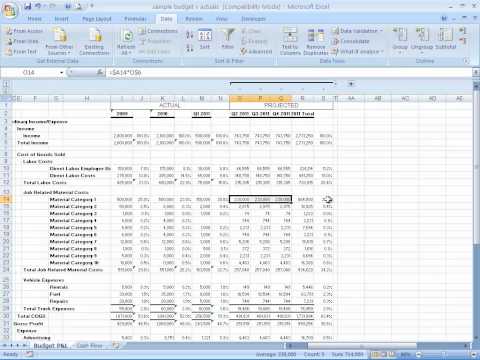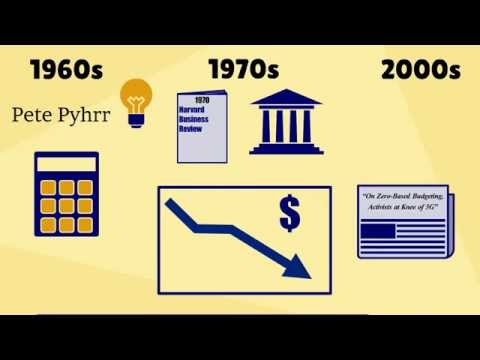Budgeting in service companies
The concepts discussed in this
chapter are equally applicable to service companies. Service firms
have service revenues and operating expenses that must be budgeted.
Projected income statements and balance sheets can be prepared for
service companies and are typically based on past performance.

A YouTube element has been excluded from this
version of the text. You can view it online here:
pb.libretexts.org/llmanagerialaccounting/?p=166
To illustrate, assume Windy Weather Company wants
to make the following changes this year to last year’s results:
- Sales will increase 5%
- Sales commissions will remain the same at 10% of sales
- Sales and administrative salaries will increase 3%
- Supplies, rent and miscellaneous expenses will remain the
same.
- Income taxes will be 30% of net income.
The budgeted income statement for this year would
be:
| Windy Weather
Company |
| Budgeted Income
Statement |
|
Last Year
|
BUDGET
|
Calculation |
| Sales |
$450,000 |
$472,500 |
450,000 + (450,000 x 5%) |
| Less Expenses: |
|
|
heading only – no entry |
| Sales Commissions |
$45,000 |
$49,500 |
472,500 x 10% |
| Sales Salaries |
$50,000 |
$51,500 |
$50,000 + (50,000 x 3%) |
| Administrative Salaries |
$75,000 |
$77,250 |
$75,000 + (75,000 x 3%) |
| Supplies Expense |
$5,000 |
$5,000 |
no
change |
| Rent Expense |
$120,000 |
$120,000 |
no
change |
| Miscellaneous Expense |
$15,000 |
$15,000 |
no
change |
| Total Expenses |
$310,000 |
$318,250 |
sum
of all expenses |
| Income from operations |
$140,000 |
$154,250 |
Sales 450,000 – Expenses 318,250 |
| Less: Income Tax (30%) |
($42,000) |
($46,275) |
Inc. from operations x 30% |
| Net Income |
$98,000 |
$107,975 |
Inc. from operations – income tax |
Zero-Based Budgeting
An alternative to the traditional budget is
zero-based budgeting.

A YouTube element has been excluded from this
version of the text. You can view it online here:
pb.libretexts.org/llmanagerialaccounting/?p=166
Zero-base budgeting became popular in the 1970s,
particularly when President Jimmy Carter supported it for state and
federal governmental units. It has received less attention since
then.
Under zero-base budgeting, managers in
a company start each year with zero budget levels and must justify
every dollar that appears in the budget. Managers do not assume any
costs incurred in previous years should be incurred this year. Each
manager prepares decision packages that describe the nature and
cost of tasks that can be performed by that unit and the
consequences of not performing each task. Top organization
officials rank the decision packages and approve those that they
believe are most worthy. A major drawback to the use of this
concept is the massive amounts of paperwork and time needed to
prepare and rank decision packages, especially in large
organizations.
Accounting in the Headlines
Why is Campbell Soup Company using zero-based
budgeting?
 Consumers are
increasingly distrusting “Big Food,” and Campbell Soup Company
(CPB) is working to counter the effects of that trend by offering
more healthy or natural alternatives. For example, Campbell’s
recently introduced a new line of organic soups, Campbell’s®
Organics, and acquired both Bolthouse Farms juices and Plum
Organics baby food.
Consumers are
increasingly distrusting “Big Food,” and Campbell Soup Company
(CPB) is working to counter the effects of that trend by offering
more healthy or natural alternatives. For example, Campbell’s
recently introduced a new line of organic soups, Campbell’s®
Organics, and acquired both Bolthouse Farms juices and Plum
Organics baby food.
In addition to expanding its healthier and
more natural product lines, Campbell’s has also announced it will
be implementing zero-based budgeting. It expects to save $200
million off its expected annual costs of close to $7 billion.
Questions
- What is “zero-based budgeting”?
- How does Campbell’s expect that it will save $200 million by
using zero-based budgeting?
- What are some potential drawbacks to Campbell’s from its use of
zero-based budgeting?
Final Thoughts
For the final thoughts on budgeting, it might be
helpful to rethink about how we create budgets, who creates them
and what motivation the person might have for the budget figures.
This video discusses the difference between participating and
traditional budgeting.

A YouTube element has been excluded from this
version of the text. You can view it online here:
pb.libretexts.org/llmanagerialaccounting/?p=166
CC licensed
content, Specific attribution
All rights
reserved content
- What is Zero-Based Budgeting (ZBB)?. Authored
by: Stroud International. Located at:
youtu.be/t0KLvsvShsk.
License: All Rights Reserved.
License Terms: Standard YouTube License
- Participative Budgeting vs. Traditional Budgeting .
Authored by: Education Unlocked. Located
at: youtu.be/m-uWeIy-whQ.
License: All Rights Reserved.
License Terms: Standard YouTube License
- How to Build a Basic Financial Projection - Business Finance .
Authored by: Gateway CFO Solutions.
Located at: youtu.be/IuL0dWfd7Jk.
License: All Rights Reserved.
License Terms: Standard YouTube License





